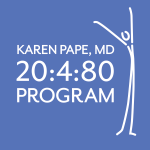 The standard message given to parents of preteen and teenagers is that their child has “plateaued”, with no further functional improvement expected. Therapy is decreased or even stopped. It is time for parents to demand a change in this outdated, incorrect practice. Teenagers bodies and brains continue to grow and mature, offering new possibilities for functional improvement. Stopping active intervention at this age leads to predictable adverse consequences. What do parents need to do?
The standard message given to parents of preteen and teenagers is that their child has “plateaued”, with no further functional improvement expected. Therapy is decreased or even stopped. It is time for parents to demand a change in this outdated, incorrect practice. Teenagers bodies and brains continue to grow and mature, offering new possibilities for functional improvement. Stopping active intervention at this age leads to predictable adverse consequences. What do parents need to do?
Doing more of the same harder doesn’t work…
The first step is to assess if there has been any measureable functional change in the last year or two. In many cases the answer is NO. The only long term outcome study1, done in Ontario where I live, demonstrated that there was no change in status for teens in GMFCS Level I and II. That is bad enough, but the functional levels in those at GMFCS III, IV and V all DETERIORTED. So, decreasing or stopping intervention clearly has consequences.
Teenagers’ bodies are like athletes on Illegal drugs…
The fact that routine therapy often does not work does NOT mean that there is nothing that will work to improve function. When you are told, “There is nothing more to do”, the truth may well be that “I do not know of anything more that will work at this age”. The goal of Pediatric therapy is to get the child to a level of function, NOT to reach their personal best function.
Teens at GMFCS Level I, II and III
A new program is needed to capitalize on all the hard work that has gotten your child to this stage. Your teenager also wants something new. The people who have the important skills needed at this age are sports and orthopedic therapists and physical trainers. Contact your local adapted sports group for some suggestions. Getting the teenager interested in adapted sports can be life changing. If there is no local contact available to you, ask the folks at Blaze Sports. www.blazesports.org
Teens at GMFCS Level III, IV and V
The first thing to do is an honest evaluation of the degree of spasticity and the state of body alignment. Body malalignment, with joint distortion and contractures, gets worse with linear growth and increases in body weight. What is tolerable as a young child is often not good enough as they grow. In my view, Botox has some usefulness early on, when the spasticity is easily controlled. But it is not a long-term answer. My advice is to search out a spasticity management clinic that has medical, neurosurgical and orthopedic input and get an opinion on what could be done to improve comfort and functionality. Once body alignment and tone has been managed you can teach the child new wyas of moving, replacing the wired-in spastic habits. More on this to follow.
I have seen some remarkable change with the right treatment at the right time.
- Peter Rosenbaum et al., “Prognosis for Gross Motor Function in Cerebral Palsy: Creation of Motor Development Curves,” JAMA 2002 (288): 1357-1363, 1358
Where can we find a spasticity management clinic and why has no one ever offered me that choice? My daughter is 13 years old and 145 lbs with spastic quad cp. We have run out of options for exercise and we get NO PT whatsoever! We live in Vaughan, ON.
Unfortunately, there are not a lot of spasticity management clinics. It is one of the areas where parental demand can be helpful. For now, ask for a neurosurgical consult re SDR or a baclofen pump.One of the problems is your daughter’s weight. So, I would start with consulting a nutritionist and figuring out how to change her diet.Hope this helps.
So true! Don’t forget the opportunities to igreatly improve alignment, flexibility and tone that can be provided through physical therapists as well as other practitioners skilled in manual therapies. It’s essential to incorporate a progressive functional and fun program as well to take full advantage of gains and develop new habits. Additionally we now know that the types of food we fuel with, significantly affects our energy and freedom from pain. Some of my most rewarding experiences are with teens who thought they’d reached their peak and, with some intentional work, find their world open wide!